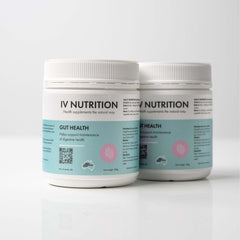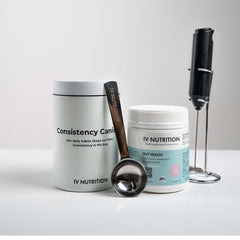The Low-FODMAP Diet: A Guide for Gut Health and IBS Relief
If you’re among the millions of people suffering from irritable bowel syndrome (IBS) or other digestive issues, you know how disruptive gut problems can be. Bloating, cramping, irregular bowel movements, and discomfort can interfere with your daily activities, leaving you feeling frustrated and, at times, helpless. That’s where the Low-FODMAP diet comes in. Scientifically backed and clinically proven, this diet has shown incredible promise in helping individuals with IBS and other gastrointestinal disorders regain control over their digestive health.
In this comprehensive guide, we’ll explore the Low-FODMAP diet, explain why it works for IBS relief, and provide practical tips for following it. Additionally, we’ll discuss the importance of prebiotics in maintaining gut health and how supplements like IV Nutrition’s Virgin Manufactured Sugarcane Prebiotic Fibre can support your journey to better digestion.
What Is the Low-FODMAP Diet?
The Low-FODMAP diet is a three-phase dietary program designed to help individuals with IBS and similar digestive conditions identify and manage their food triggers. FODMAP stands for Fermentable Oligosaccharides, Disaccharides, Monosaccharides, and Polyols, which are short-chain carbohydrates (sugars) that can be poorly absorbed in the small intestine.
When these fermentable sugars enter the colon, they are fermented by gut bacteria, leading to the production of gas and other by-products that can cause bloating, discomfort, and other IBS symptoms. The Low-FODMAP diet works by eliminating or reducing foods that contain high levels of these fermentable sugars, helping to alleviate digestive distress.
The Low-FODMAP diet is not meant to be followed long-term. It’s primarily used as a diagnostic tool to identify food triggers and is followed in a structured, three-phase process.
The Three Phases of the Low-FODMAP Diet
1. Elimination Phase
The first phase involves eliminating all high-FODMAP foods from your diet for about 4-6 weeks. During this time, your gut will have the chance to heal and reset. Common high-FODMAP foods include:
- Dairy products like milk and yogurt
- Certain fruits such as apples, pears, and watermelon
- Wheat-based foods like bread, pasta, and some cereals
- Certain vegetables including onions, garlic, and cauliflower
- Legumes such as beans, lentils, and chickpeas
- Artificial sweeteners like sorbitol, mannitol, and xylitol
By removing these foods from your diet, you allow your gut to reduce inflammation and lessen IBS symptoms.
2. Reintroduction Phase
Once you’ve completed the elimination phase and your symptoms have improved, the next step is to gradually reintroduce high-FODMAP foods one by one. This is done in a structured manner to help pinpoint which specific FODMAPs trigger symptoms for you. For example, you may reintroduce dairy first and monitor your symptoms for a few days, followed by wheat, then fruits, and so on.
This phase can take several weeks, but it’s crucial to understand how your body reacts to each type of FODMAP.
3. Personalization Phase
After identifying your personal triggers in the reintroduction phase, the final phase is about creating a balanced, long-term eating plan that includes the foods you can tolerate. You’ll also continue to avoid the foods that cause distress. The goal is to maintain a nutrient-dense, enjoyable diet while minimizing IBS symptoms.
It’s important to note that the Low-FODMAP diet isn’t about permanent food avoidance but rather about learning to manage your triggers.
How the Low-FODMAP Diet Helps Relieve IBS Symptoms
For many people with IBS, FODMAPs act as irritants that disrupt the normal function of the digestive system. Here’s how reducing FODMAPs can help:
1. Reduces Gas and Bloating
High-FODMAP foods can ferment in the gut, leading to excess gas and bloating. By eliminating or reducing these foods, you reduce the amount of gas produced, leading to a more comfortable digestive process.
2. Eases Abdominal Pain and Cramping
Fermentation in the gut can also cause abdominal discomfort, cramps, and a feeling of fullness. By identifying and avoiding specific FODMAP triggers, the pain and cramping often associated with IBS can be significantly reduced.
3. Normalizes Bowel Movements
The Low-FODMAP diet can help normalize both diarrhea and constipation, two common symptoms of IBS. FODMAPs are known to draw water into the intestines, which can worsen diarrhea. By reducing the intake of high-FODMAP foods, bowel movements become more regular and easier to manage.
4. Reduces Inflammation
Some FODMAPs, especially certain oligosaccharides, can lead to inflammation in the gut. The elimination of these foods can help reduce intestinal inflammation and improve the overall health of your digestive system.
The Science Behind the Low-FODMAP Diet
The Low-FODMAP diet is not just a trendy fad but is rooted in scientific research. Studies have shown that up to 70% of people with IBS experience relief from their symptoms when following the diet correctly. A randomized controlled trial published in the journal Gastroenterology found that participants who followed the Low-FODMAP diet had a significant reduction in IBS symptoms, including pain, bloating, and bowel irregularity.
Additionally, the diet has been shown to improve the diversity of gut microbiota, which plays a crucial role in maintaining digestive health. Research indicates that imbalances in gut microbiota (dysbiosis) are linked to IBS and other gastrointestinal disorders. By reducing gut irritation with the Low-FODMAP diet, the composition of gut microbiota can shift to support better digestion and overall health.
Practical Tips for Following the Low-FODMAP Diet
Navigating the Low-FODMAP diet can be challenging at first, especially since many of the foods we commonly eat contain FODMAPs. However, with some careful planning and a few key tips, you can stay on track:
1. Plan Your Meals Ahead of Time
Meal planning is essential when following the Low-FODMAP diet. Many high-FODMAP foods are hidden in sauces, dressings, and processed foods. Stick to whole foods like lean proteins, non-starchy vegetables, and gluten-free grains to simplify things.
2. Be Mindful of Serving Sizes
Even some foods that are considered low in FODMAPs can cause issues if eaten in large quantities. For example, while carrots are low-FODMAP, consuming large amounts of them may still lead to digestive discomfort. Pay attention to serving sizes.
3. Keep a Food Journal
Tracking what you eat and how you feel can help you spot patterns and identify your triggers during the reintroduction phase. A food journal can be incredibly valuable in narrowing down your personal FODMAP sensitivities.
4. Use FODMAP Apps
There are several apps available that can help you identify high and low-FODMAP foods. These can be a lifesaver when you’re at the grocery store or eating out.
5. Don’t Be Afraid to Seek Professional Guidance
The Low-FODMAP diet can be complex, especially during the elimination and reintroduction phases. It’s highly recommended to work with a registered dietitian who specializes in gastrointestinal disorders to ensure you're following the diet correctly and maintaining balanced nutrition.
Supporting Gut Health with Prebiotics
While the Low-FODMAP diet is an excellent tool for IBS relief, it’s also important to support long-term gut health. One way to do this is by incorporating prebiotic fibers into your diet. Prebiotics are non-digestible fibers that serve as food for beneficial gut bacteria, helping them thrive and promote digestive balance.
However, many high-FODMAP foods are also rich in prebiotics, which makes it challenging to consume enough of them while on a Low-FODMAP diet. This is where a high-quality prebiotic supplement can come in handy.
Introducing IV Nutrition’s Virgin Manufactured Sugarcane Prebiotic Fibre
If you're on a Low-FODMAP diet and looking for a prebiotic fiber that won’t disrupt your gut, consider IV Nutrition’s Virgin Manufactured Sugarcane Prebiotic Fibre. This product is derived from high-quality sugarcane and is designed to promote the growth of beneficial gut bacteria without the typical FODMAP-related side effects. It is gentle on your digestive system and works to support digestion, improve immune function, and even promote healthy bowel movements.
Not only is it easy to incorporate into your daily routine, but it’s also free from additives and preservatives, making it a clean and natural option for gut health.
Special Offer: 100% Off Your First Tub!
Want to try IV Nutrition’s Virgin Manufactured Sugarcane Prebiotic Fibre for yourself? You’re in luck! You can get your first tub free when you subscribe. That’s right—absolutely 100% off your first tub. Take advantage of this offer and start supporting your gut health today.
Claim Your Free Tub of Prebiotic Fibre
Conclusion
The Low-FODMAP diet offers a proven and scientifically backed approach to managing IBS symptoms and improving gut health. By following the diet in its structured phases, you can identify your personal food triggers and enjoy a more comfortable digestive experience. Don’t forget that maintaining gut health goes beyond food restrictions—incorporating prebiotics like IV Nutrition’s Virgin Manufactured Sugarcane Prebiotic Fibre can help support long-term digestive health.
If you’re struggling with IBS or digestive discomfort, the Low-FODMAP diet is a game changer. Give it a try, and don't hesitate to add prebiotic fibers to your regimen to maintain a balanced, healthy gut.
FAQs
-
What are FODMAPs?
- FODMAPs are short-chain carbohydrates that can cause digestive distress in people with IBS. They include sugars like lactose, fructose, and certain fibers.
-
How long does it take to see results from the Low-FODMAP diet?
- Most people experience significant relief from IBS symptoms within a few weeks of starting the elimination phase of the Low-FODMAP diet.
-
Can I follow the Low-FODMAP diet long-term?
- The Low-FODMAP diet is meant to be followed temporarily to identify food triggers. A long-term, personalized diet plan should be created in the final phase.
-
Can prebiotics help with IBS?
- Yes, prebiotics support the growth of beneficial gut bacteria, which can help improve digestion and alleviate IBS symptoms.
-
Is IV Nutrition’s Virgin Manufactured Sugarcane Prebiotic Fibre safe?
- Yes, it is made from natural sugarcane, free from additives, and is gentle on the digestive system, making it safe for most individuals.





